A while ago I found an old Italian recipe for preserving chanterelles in vermouth. I wanted to try preserving winter chanterelles the same way. I figured I'd use vodka as the mild flavor would show off the chanterelle flavor. It makes for a fun sip on special occasions.
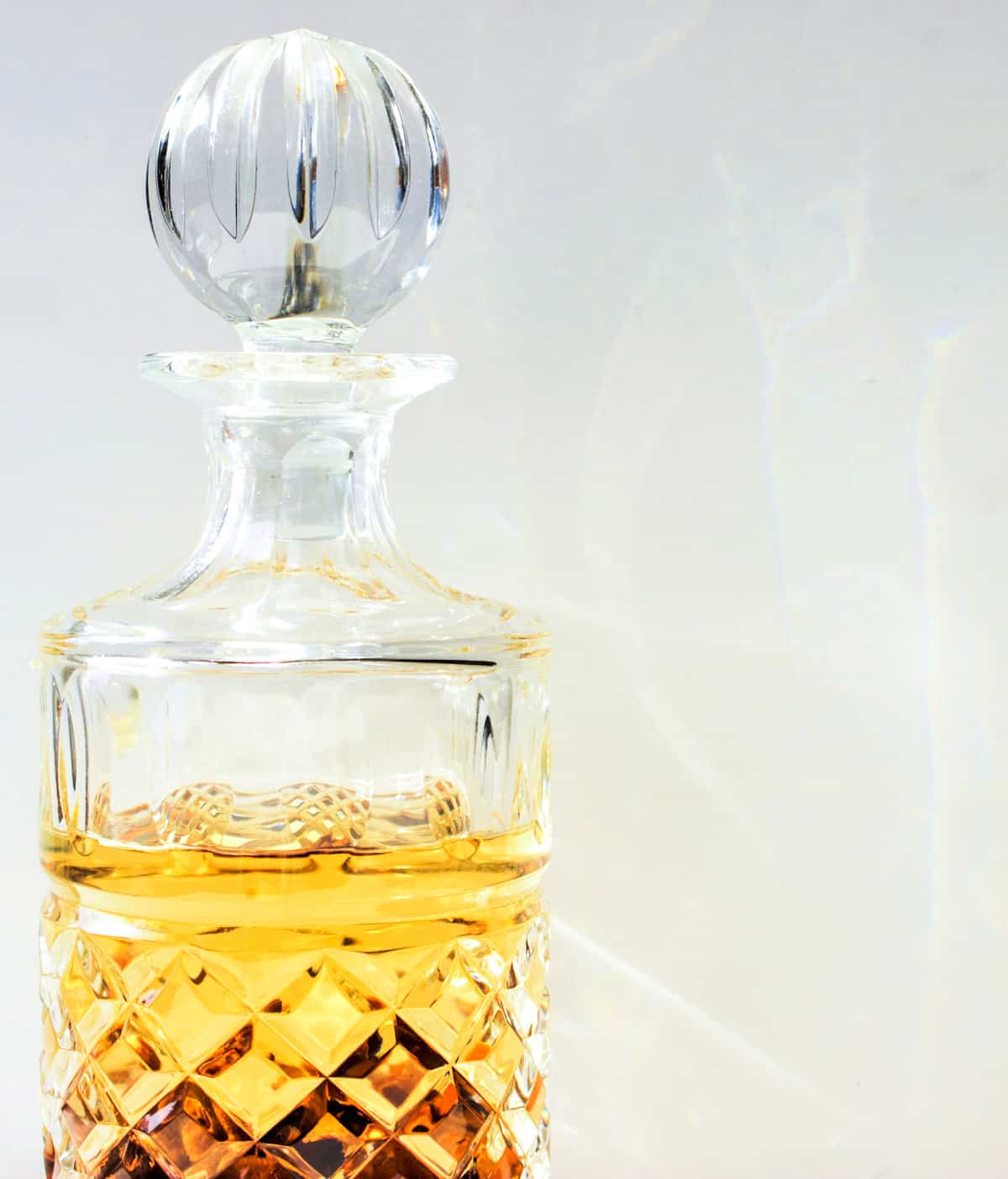
Believe it or not, mushroom spirits distilleries are a thing, and here and there you can get sips of mushroom drinks in tasting rooms. But it's more fun to make them yourself with wild mushrooms.
If you don't hunt mushrooms, check your local farmers market in the summer or contact a mushroom farm.
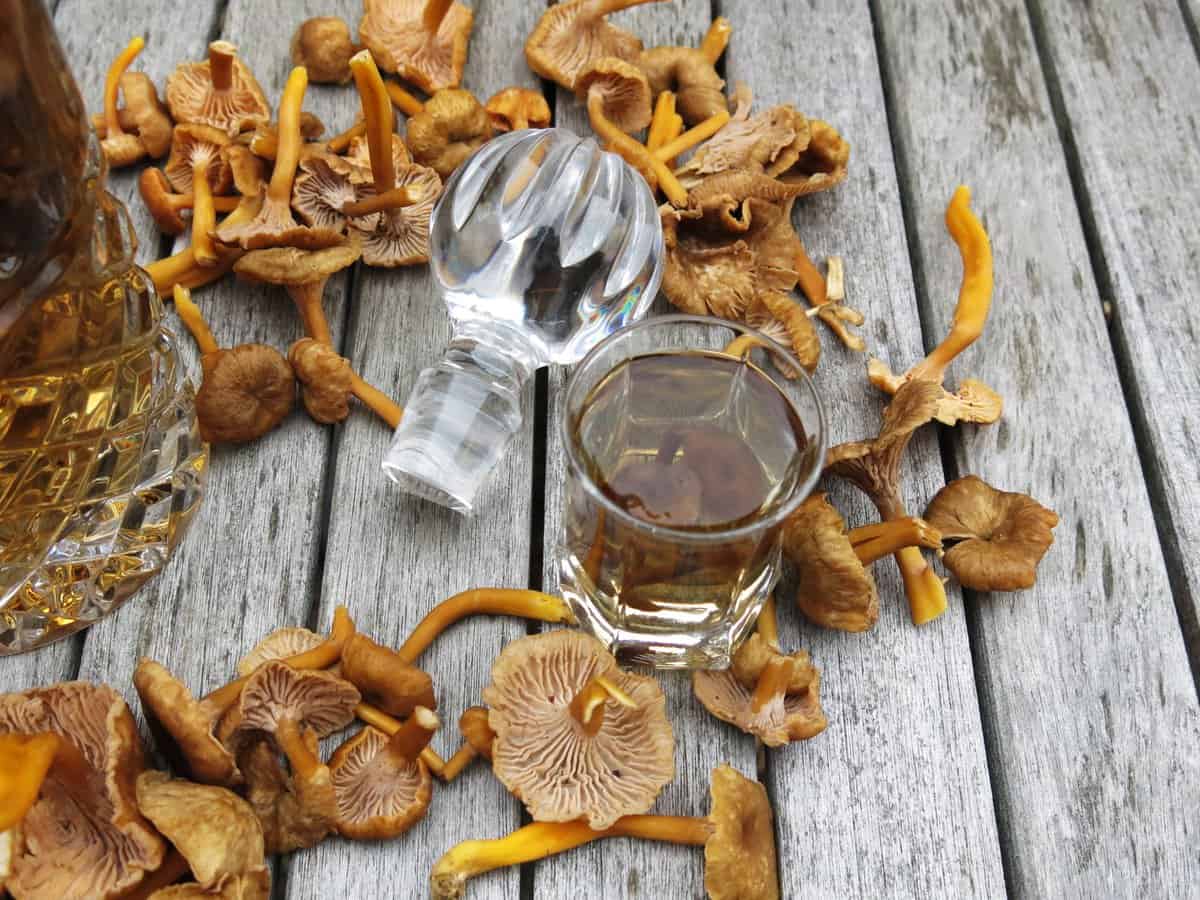
Varieties to use for a mushroom liqueur
Every mushroom will taste different, and some are better than others. Here's a few others that will make a good mushroom flavored liqueur:
- Dried candy caps
- Dried morels
- Black trumpet mushroms, fresh or dried
Black trumpets will make a black liquor, or how about a chanterelle family infused liqour made with golden chanterelles, hedgehogs and yellowfeet?
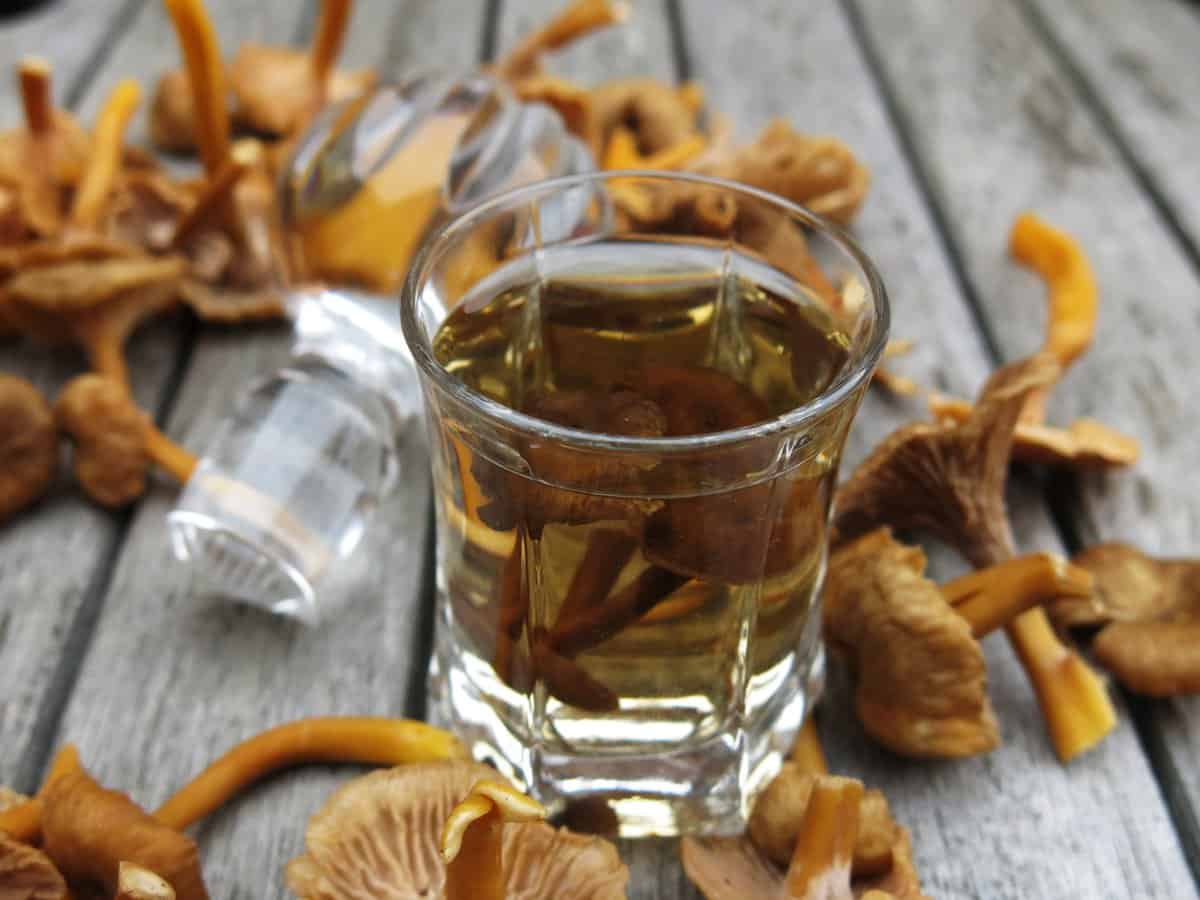
Using dried mushrooms
Dried mushrooms have a concentrated flavor, and some species like morels and porcini are better for sweet preparations when dried. Grocery stores sell dried golden chanterelles and those can work well here too.
Making a Sweet Chanterelle Cordial
Italians make a cordial with golden chanterelles. To make that, follow the recipe below and add some simple syrup or sugar to taste after the liquor has infused. Yellowfoot chanterelles have a more earthy taste than the fruity aroma of golden chanterelles.
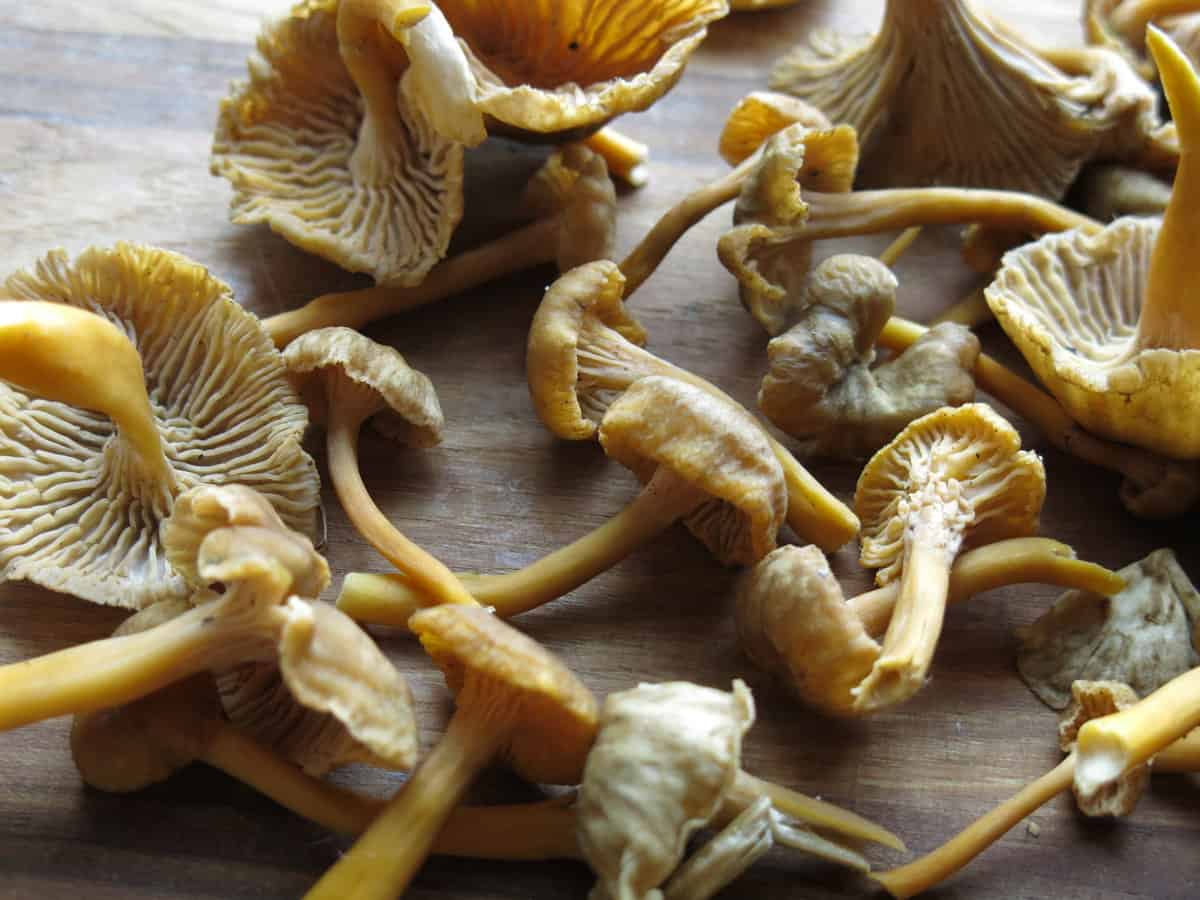
Storing
Over time the flavor can mellow so I keep it in the fridge after infusing at room temperature.
Serving
I prefer mushroom vodka straight up, as a shot. If you make the mushroom liqueur sweet, you can serve it after dinner like you would a dessert wine.
Here's a simple proportion for the infused vodka.
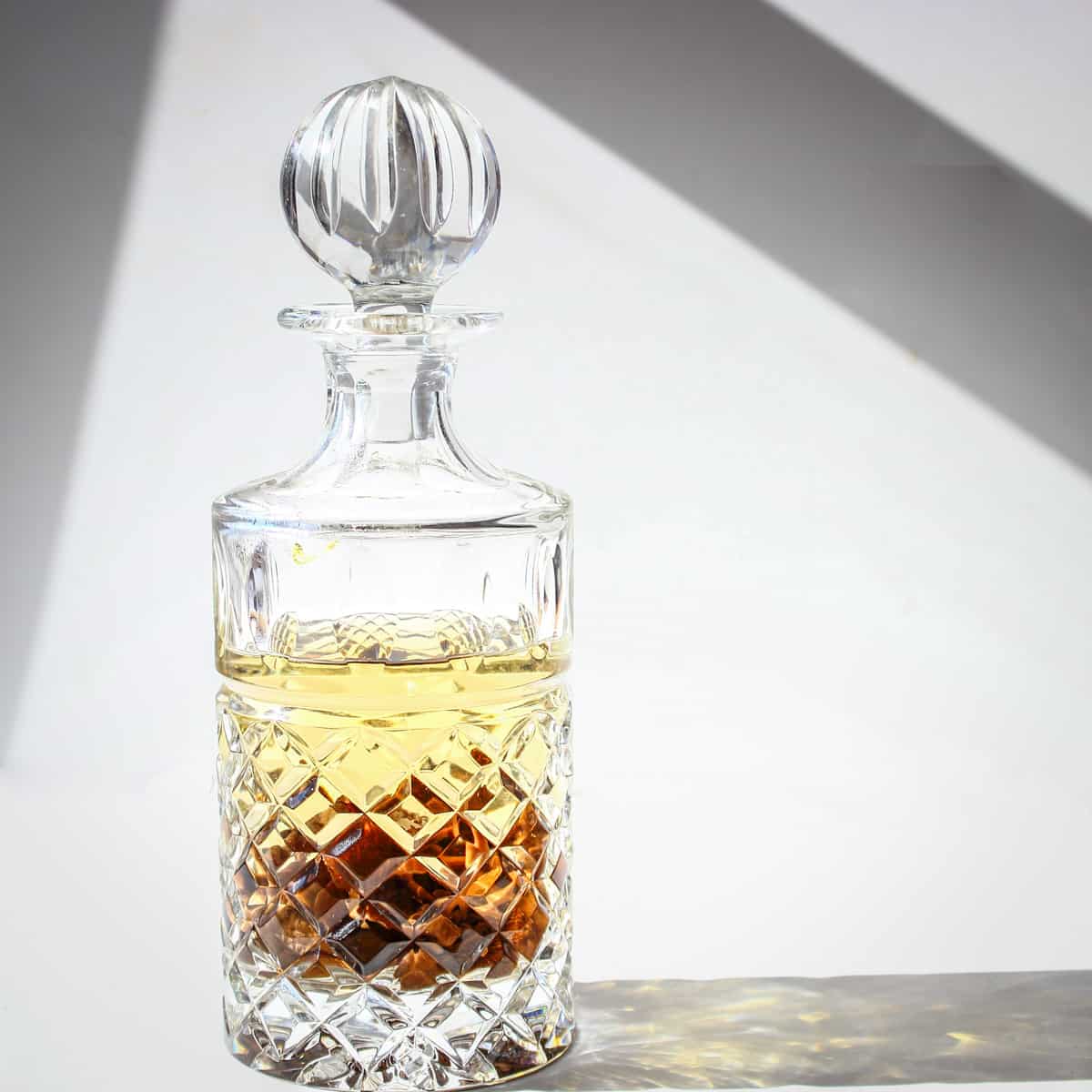
More Drinks and Liquors
- Highbush Cranberry Vodka
- Cassis: The Blackcurrant Liqueur
- Homemade Rowanberry Liqueur
- Nocino: The Black Walnut Liqueur
Chanterelle Infused Mushroom Vodka
Ingredients
- 4 oz or so fresh chanterelle mushrooms small mushrooms are my favorite but you can use larger ones cut up too
- .75 litres fine vodka
- ½ cup granulated white sugar or to taste (optional) *see note
Instructions
- Clean the chanterelles of debris using a small brush or if they are really filthy, by rinsing quickly under some cold running water.
- Combine the chanterelles and the vodka in an air-tight, nonreactive container, like a glass mason jar. Add the sugar if using and stir until it dissolves. An alternate method would be to just stuff the mushrooms in the bottle after taking a healthy pull, but then they'll be harder to remove.
- Store the mushroom vodka in a cool place away from sunlight for at least 1 week, then refrigerate to keep the aroma and enjoy. The vodka flavor will eventually smooth out and get mild.


Joey
Definitely want to try this with my dried candy caps. What ratio would you recommend? I'm also wanting to make a strong candy cap extract for the kitchen. Any thoughts on a good vodka to dried candy cap ratio? Thank you so much. I use your recipes quite frequently.
Alan Bergo
Hey Joey. I would start with half an ounce for a quart of alcohol. As for an extract, you're going to get a lot more mileage from them if you just add powdered candy caps to things. Dairy is the easiest way to harness the flavor with the smallest amount as sotolon (the compound in candy caps) is fat soluble. If you haven't put a few tablespoons of candy cap powder in cornbread too definitely try that. I'm always here if you have follow up questions. Appreciate you commenting.
Alison Gardner
I have been making candy cap brandy for years. I use them dried, and pick out small ones that will just shove into the bottle. Add a bunch of sugar, to taste, and let sit a few weeks. When the brandy is used up, you can use a chopstick to get the candy caps out, and use them in cooking.
Alison Gardner
Oh, and other good alcohol-based mushroom drinks are Matsutake sake--don't add too much, just about a quarter cup minced matsutake in a bottle of sake. And another is a turkey tail elixir; turkey tail mushrooms, with some herbs: a little thyme, oregano and rosemary, soaked in vodka. Go easy on the herbs or they will overpower the mushrooms.
Krista
I filled a half gallon bell jar 1/4 full of sliced fresh golden chanterelles and then added vodka to the top. After two days in the dark at room temp, it’s heavenly. Thinking I might strain pretty soon. Since we aren’t supposed to eat uncooked chanterelles is this ok to drink?
John Garvey
For what my opinion is worth, I understand chanterelles can be eaten raw - it's just that they are better cooked in most dishes because it brings out the flavour.
Infusing in vodka will do that anyway.
I used golden chanterelles in vodka and got an interesting amber, woody/apricot flavour schnapps. It won't catch on commercially, I guess, but certainly interesting and palatable....
Ben
Hey, love the article...sipping on my own few week old batch right now.
Curious if you have any info on whether or not the mushrooms themselves are good for eating straight up, once they've been in the vodka for a good amount of time? I feel like they'd be ok and one time cooked them into Vodka Yellowfoot Drunk Brownies but n'er have eaten them straight up out of the vodka.
Think they'd be good? Think you'd get indigestion? Drunk and both at the same time?
Thanks Forager Chef. Love using your resources as a digital sounding board for my mushroom dishes. Will likely check tomorrow for a cream of Morel recipe. Just to be sure its good! 🙂
Cheers,
Ben Dreamflayer
p.s. am illustrator.animator if need mushroom art for articles.
Alan Bergo
Thanks Ben
Melissa
I have been doing this with dried Reishi for a medicinal cocktail!
Bonnie
Is the yellow foot infused vodka good for drinking straight or do you have cocktail recipes you and suggest? I have some fermenting in my liquor cabinet
Alan Bergo
I would use with salty garnishes, like olives, etc, not too much or you won't taste it.
Bonnie
Great, thank you! 🙂
eub
For mushrooms you wouldn't eat uncooked (whatever your personal practice is), would you have concerns about raw infusion? The alcohol will kill bugs, but it won't degrade unstable compounds or remove volatiles (like fragrance!), so I wondered how you assess it.
samantha
Hi Alan- You used fresh chanterelles here, is it better at all to dry the mushrooms before infusing? I guess when I make tinctures and infusions with reishi, chaga, turkey tail, I always tend to dry them first, maybe I was worried a bit about a mold or something developing on the surface. If you haven't had any trouble with this, I might give an infusion with fresh matsutake a try this fall... Feel like their super aromatic qualities would impart awesome flavor in vodka for a pretty neat wild cocktail, cordial, vermouth, or even a tincture with grain alcohol. Matsutake don't dry super well and lose that magical fresh scent if they're dried from my experience, so they might be a good one to infuse fresh...
Alan Bergo
For aromas, except for candy caps, it is really better to use them fresh since drying changes the scent.
Greg
I just made my first batch of yellowfoot (Craterellus tubaeformis)-infused vodka. I used Crater Lake Vodka (it's good) and I used mostly yellowfeet but also some "regular" chanterelles (Cantharellus cibarius) as well. I estimate that I used no more than 30 chanterelles to a 750ml bottle of vodka. I combined the vodka and chanterelles in a mason jar and they have been infusing in the fridge for at least 3 weeks now.
To my surprise, however, the whole concoction is now a dark, nearly black, black tea color. Even the chanterelles have now turned nearly black (a dark brown) after infusing. I am curious what is causing this...
Alan Bergo
Interesting, haven't seen that happen before.
Toby
Yellowfoot vodka almost always turns the color of weak black tea. Regular chanterelle vodka varies wildly, sometimes it is pale gold, other times more of an amber. Every so often I have a batch turn very dark brown. No difference in the vodka (monopolova) and sometimes it happens with just one jar out of a batch I made all at the same time.
I am guessing that it is some kind of oxidation reaction, but that doesn't make perfect sense since none of the older bottles have ever changed even when decanting or repacking into little nip bottles for gifts.
I was initially reluctant to drink the dark vodka, but given several that turned were gallon jugs I found the courage to try. And...it tastes fine.
Other things to try:
Hedgehog infused vodka
Laccaria vodka - doesn't matter if you use L. laccata or L. amythystio-occidental, it usually turns out sort of dingy gray/tan. Make small batches, it is not for everyone.
Leave the duff on - Sometimes we clean our chanterelles really well before making vodka. Other times they just get coarsely chopped into a jar. I mean, we do a decent cleaning in the field but in my experience a little dirt and moss and leaves and twigs and pine needles can really add depth to the infusion. An easy way to start is if you pull down a huge haul and, while cleaning them up for processing just do it on tea towels. After they are all cooked bagged frozen (or however you do) just tip the "crumbs" into a Mason jar and infused as usual. I do try to avoid questionable bits (waterlogged or dark pieces) in my infusion so if I trim those go in the compost rather than the vodka.
Good luck, don't be afraid of the dark... ☺
oilgod
My wife and I have been infusing mushrooms in vodka for about 5 years now so hopefully I can contribute some of that experience.
The first thing I'd offer is that most mushrooms do not have to be cleaned before infusion. We don't rinse or even brush very aggressively - pine needles and duff add character and flavor to the final product and any dirt will settle out or can be filtered with cheesecloth.
Agreed that for infusion time, longer is usually better. Still, there is usually ample flavor to enjoy a sample even after only a week with most species so you can appreciate the development as they soak...
In addition to chanterelles, hedgehog mushrooms also work very well in a vodka infusion. These are one of our favorite eating mushrooms so we typically only make an infusion if there is a very large supply. A hotter vodka (one with more bite or sharper mouthfeel) works great with hedgehogs since that is sort of how they taste raw normally.
Yellowfoot chanterelles are probably our highest rated infusions but take a ton of time to collect due to their size so we do other individual species as separate infusions. Blends with chanterelles and hedgehogs and trimmings/crumbs from the collecting baskets added are delicious, if not quite as distinct.
In our experience, the greater the volume of mushrooms infused, the stronger the flavor of the liquor. Regular chanterelles become almost overpowering once past a certain percentage, so I recommend using no more than 50% coarsely chopped mushrooms by total volume of filled container (e.g. 1 quart would be 1 pint loosely packed chopped chanterelles then fill to top with vodka.)
The chopped chanterelles are still usable after extraction, try them pureed for a penne alla vodka or similar. That is assuming they were cleaned really well prior to infusion - no fun chewing on pine needles or whatnot. Yellowfoot mushrooms lose some of their robust texture but can still fill an omelette or round out a hash.
We typically drink the infusions neat to fully appreciate the flavors - a lot of the nuance is blown off with cooking so using them in a dish prior to serving seems like a waste. For a cooking mushroom vodka, do a super-infusion: fill a jar to the brim with coarsely chopped mushrooms and then fill the remaining space between the chunks with vodka. This results in a very strongly flavored liquor that should stand up better in a recipe.
Laccaria sp. and Clitocybe odora can also be infused into vodka but the results are strongly flavored and will probably not agree with all palates. We've not yet tried any bolete or lactarius species as infusions because those are some of our favorite eating mushrooms. If we get a large enough harvest this year we'll give them a go...
I hope this helps!